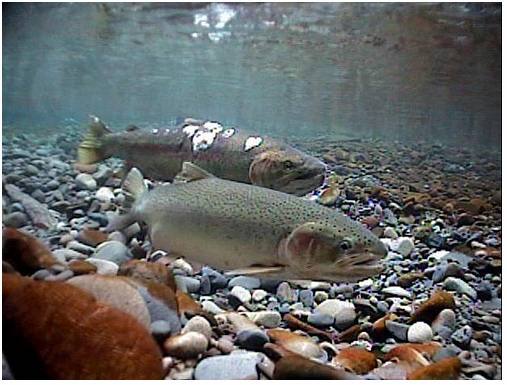LOSS OF RIVER COMPLEXITY CONTRIBUTES TO FLOODING, BUT FISH SHOULD SURVIVE
1-20-12
CORVALLIS, Ore. – In the space of a few days, many rivers in western Oregon have gone from near-record low levels to flood stage, jeopardizing riverside homes, causing flooding and challenging Chinook salmon, steelhead and other native fishes.
The reason for the high water is mostly evident – heavy rainfall from a strong “pineapple express” storm from the southwest has pounded western Oregon and melted the snowpack, adding to the flood peak. But decades of human alterations to Oregon’s river systems has also contributed to worsening the situation, according to hydrologists.
What once were complex, braided rivers, with multiple channels that spread the impact of flooding, have been transformed into single channels that act like pipelines, according to Oregon State University ecologist Stan Gregory.
“Historical river systems were much more complex and their multiple channels spread the impact of the flooding, and slowed the currents,” said Gregory, a professor of fisheries and wildlife at OSU. “It also created holding places for migrating and resident fish. But dams, development, and the transition from natural forests to housing tracts and pastures have eliminated complexity from many river systems.”
Gregory says salmon, steelhead and native fish should be able to survive the floods. After all, they have had thousands of years to adapt to flooding. There can be short-term damage, however, he pointed out. Recently deposited eggs and young fry can be washed downriver. However, steelhead typically migrate from Thanksgiving through March – or longer – in many rivers, so single flooding events rarely result in catastrophe for all fish.
The impact of a single flood event on steelhead is hard to gauge, Gregory says, because the juvenile fish live in streams from one to three years and then go out to the ocean where most spend one or two years. A flood can affect a part of the overall steelhead population, while other individuals are in the ocean phase of their life.
“Adult steelhead are large, strong fish and can navigate most rivers even at flood stage,” Gregory said. “And flooding is actually beneficial in many cases. It can improve habitat by scouring out river bottoms, creating new pools and cleaning out silt.
“We have found populations of cutthroat trout in streams in the Cascade Mountains to be highest in the summers following the largest floods,” he added, “while winters with low flooding are followed by low populations.”
Smaller native fish also have proven adept at surviving floods – and using what humans have provided for them. In 2009, OSU ecologist Guillermo Giannico and his colleagues published a study that found farmers’ fields that are inundated with floodwater play a role in creating a sanctuary for native fish, where they may find both food and temporary shelter from fast waters and introduced fish species.
“Floods have always been a dynamic part of the system, much the same way that snow is for elk in Yellowstone,” said Giannico, also a faculty member in OSU’s Department of Fisheries and Wildlife. “Over time, animals will adapt to get the most out of their habitat.
“We have found that native fish have adjusted their behavior to use these floodplains, mostly in agricultural lands, to great benefit,” Giannico said.

